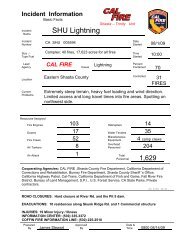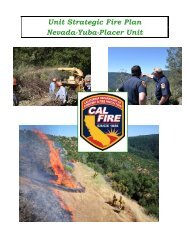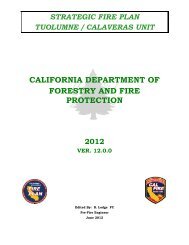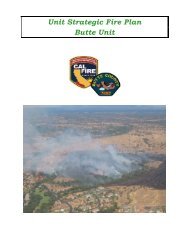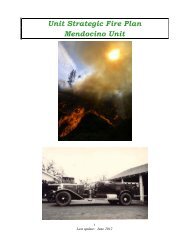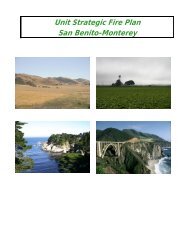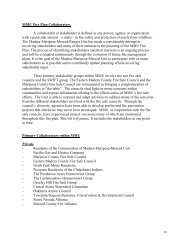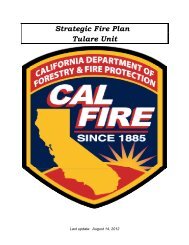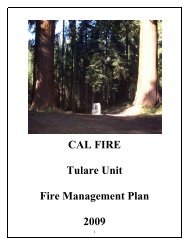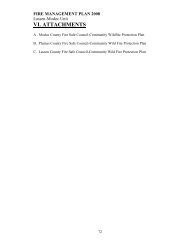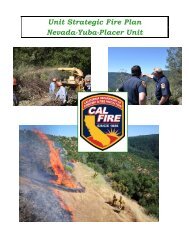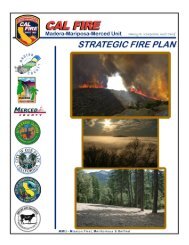Sonoma-Lake-Napa Fire Plan - Board of Forestry and Fire ...
Sonoma-Lake-Napa Fire Plan - Board of Forestry and Fire ...
Sonoma-Lake-Napa Fire Plan - Board of Forestry and Fire ...
You also want an ePaper? Increase the reach of your titles
YUMPU automatically turns print PDFs into web optimized ePapers that Google loves.
<strong>Sonoma</strong>-<strong>Lake</strong>-<strong>Napa</strong> Unit<br />
<strong>Fire</strong> Management <strong>Plan</strong><br />
2005<br />
California's<br />
central <strong>and</strong> northern coastal counties. It has also been found to infect the<br />
leaves <strong>and</strong> twigs <strong>of</strong> numerous other plants species. While many <strong>of</strong> these foliar hosts, such<br />
as California bay laurel <strong>and</strong> Rhododendron species, do not die from the disease, they do<br />
play a key role in the spread <strong>of</strong> P. ramorum, acting as breeding ground for innoculum,<br />
which may then be spread through wind-driven rain, water, plant material, or human<br />
activity. P. ramorum thrives in cool, wet climates. 9<br />
This gross dieback <strong>of</strong> native vegetation at such a large level with no solution in<br />
sight, will increase the fuel loading available to burn <strong>and</strong> dramatically increase fire<br />
behavior. Because the disease also weakens the trees, there is an increased danger to<br />
firefighters working under or near them.<br />
E. Structure Fuels<br />
One incomplete aspect <strong>of</strong> the previously discussed vegetative wildfire fuels<br />
analysis is the consideration<br />
<strong>of</strong> structures located within the wildl<strong>and</strong> areas. To a wildfire,<br />
a structure is just another fuel. And as mentioned before, the only element <strong>of</strong> the three<br />
environmental elements<br />
that influence the behavior<br />
<strong>of</strong> wildfire that we, as<br />
humans, can change is<br />
fuel. If a structure is in the<br />
planning stages, design <strong>and</strong><br />
construction material<br />
recommendations can be<br />
made to make the structure<br />
less prone to be ignited by<br />
a wildfire. However, if the<br />
structure is already built,<br />
the easiest factor to change<br />
may be to implement<br />
various fuel modifications Photo 14: Structures Destroyed by Wildfire During 2004 <strong>Fire</strong> Season<br />
around the structures in<br />
order to protect them form encroaching wildfires. Public Resources Code (PRC) 4291<br />
addresses fuel modification <strong>and</strong> the concept <strong>of</strong> “defensible space.” Defensible space can<br />
both be thought <strong>of</strong> for protecting a structure <strong>and</strong> also providing firefighters with a safe<br />
environment to position their fire apparatus <strong>and</strong> perform the necessary function to prevent<br />
the structure from igniting. Unfortunately, the proper building construction <strong>and</strong><br />
defensible space cannot guarantee that the structure will survive all wildfire possibilities.<br />
The following excerpt is from a paper prepared by CDF Battalion Chief Ethan<br />
Foote, who is assigned to CDF’s Northern Region <strong>of</strong>fice in Santa Rosa. Besides writing<br />
9 th<br />
California Oak Mortality Task Force website. Accessed June 10 , 2005.<br />
- 38 -



